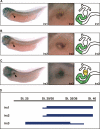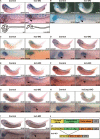The prepattern transcription factor Irx3 directs nephron segment identity
- PMID: 17875669
- PMCID: PMC1973149
- DOI: 10.1101/gad.450707
The prepattern transcription factor Irx3 directs nephron segment identity
Abstract
The nephron, the basic structural and functional unit of the vertebrate kidney, is organized into discrete segments, which are composed of distinct renal epithelial cell types. Each cell type carries out highly specific physiological functions to regulate fluid balance, osmolarity, and metabolic waste excretion. To date, the genetic basis of regionalization of the nephron has remained largely unknown. Here we show that Irx3, a member of the Iroquois (Irx) gene family, acts as a master regulator of intermediate tubule fate. Comparative studies in Xenopus and mouse have identified Irx1, Irx2, and Irx3 as an evolutionary conserved subset of Irx genes, whose expression represents the earliest manifestation of intermediate compartment patterning in the developing vertebrate nephron discovered to date. Intermediate tubule progenitors will give rise to epithelia of Henle's loop in mammals. Loss-of-function studies indicate that irx1 and irx2 are dispensable, whereas irx3 is necessary for intermediate tubule formation in Xenopus. Furthermore, we demonstrate that misexpression of irx3 is sufficient to direct ectopic development of intermediate tubules in the Xenopus mesoderm. Taken together, irx3 is the first gene known to be necessary and sufficient to specify nephron segment fate in vivo.
Figures








Similar articles
-
Nephron proximal tubule patterning and corpuscles of Stannius formation are regulated by the sim1a transcription factor and retinoic acid in zebrafish.Dev Biol. 2015 Mar 1;399(1):100-116. doi: 10.1016/j.ydbio.2014.12.020. Epub 2014 Dec 25. Dev Biol. 2015. PMID: 25542995 Free PMC article.
-
The Xenopus Irx genes are essential for neural patterning and define the border between prethalamus and thalamus through mutual antagonism with the anterior repressors Fezf and Arx.Dev Biol. 2009 May 15;329(2):258-68. doi: 10.1016/j.ydbio.2009.02.028. Epub 2009 Mar 4. Dev Biol. 2009. PMID: 19268445
-
Homeogene emx1 is required for nephron distal segment development in zebrafish.Sci Rep. 2018 Dec 21;8(1):18038. doi: 10.1038/s41598-018-36061-4. Sci Rep. 2018. PMID: 30575756 Free PMC article.
-
Xenopus: a prince among models for pronephric kidney development.J Am Soc Nephrol. 2005 Feb;16(2):313-21. doi: 10.1681/ASN.2004070617. Epub 2005 Jan 12. J Am Soc Nephrol. 2005. PMID: 15647339 Review.
-
Patterning the nephron: Forming an axial polarity with distal and proximal specialization.Curr Top Dev Biol. 2025;163:83-103. doi: 10.1016/bs.ctdb.2025.01.005. Epub 2025 Jan 28. Curr Top Dev Biol. 2025. PMID: 40254351 Review.
Cited by
-
Transcription factors AP-2α and AP-2β regulate distinct segments of the distal nephron in the mammalian kidney.Nat Commun. 2022 Apr 25;13(1):2226. doi: 10.1038/s41467-022-29644-3. Nat Commun. 2022. PMID: 35468900 Free PMC article.
-
Iroquois transcription factor irx2a is required for multiciliated and transporter cell fate decisions during zebrafish pronephros development.Sci Rep. 2019 Apr 23;9(1):6454. doi: 10.1038/s41598-019-42943-y. Sci Rep. 2019. PMID: 31015532 Free PMC article.
-
Epigenetic Regulators of White Adipocyte Browning.Epigenomes. 2021 Jan 12;5(1):3. doi: 10.3390/epigenomes5010003. Epigenomes. 2021. PMID: 34968255 Free PMC article. Review.
-
Tfap2a is a novel gatekeeper of nephron differentiation during kidney development.Development. 2019 Jul 10;146(13):dev172387. doi: 10.1242/dev.172387. Development. 2019. PMID: 31160420 Free PMC article.
-
Nephron Patterning: Lessons from Xenopus, Zebrafish, and Mouse Studies.Cells. 2015 Sep 11;4(3):483-99. doi: 10.3390/cells4030483. Cells. 2015. PMID: 26378582 Free PMC article. Review.
References
-
- Aldaz S., Morata G., Azpiazu N., Morata G., Azpiazu N., Azpiazu N. The Pax-homeobox gene eyegone is involved in the subdivision of the thorax of Drosophila. Development. 2003;130:4473–4482. - PubMed
-
- Allanson J.E., Hunter A.G., Mettler G.S., Jimenez C., Hunter A.G., Mettler G.S., Jimenez C., Mettler G.S., Jimenez C., Jimenez C. Renal tubular dysgenesis: A not uncommon autosomal recessive syndrome: A review. Am. J. Med. Genet. 1992;43:811–814. - PubMed
-
- Bao Z.Z., Bruneau B.G., Seidman J.G., Seidman C.E., Cepko C.L., Bruneau B.G., Seidman J.G., Seidman C.E., Cepko C.L., Seidman J.G., Seidman C.E., Cepko C.L., Seidman C.E., Cepko C.L., Cepko C.L. Regulation of chamber-specific gene expression in the developing heart by Irx4. Science. 1999;283:1161–1164. - PubMed
-
- Bellefroid E.J., Kobbe A., Gruss P., Pieler T., Gurdon J.B., Papalopulu N., Kobbe A., Gruss P., Pieler T., Gurdon J.B., Papalopulu N., Gruss P., Pieler T., Gurdon J.B., Papalopulu N., Pieler T., Gurdon J.B., Papalopulu N., Gurdon J.B., Papalopulu N., Papalopulu N. Xiro3 encodes a Xenopus homolog of the Drosophila Iroquois genes and functions in neural specification. EMBO J. 1998;17:191–203. - PMC - PubMed
Publication types
MeSH terms
Substances
LinkOut - more resources
Full Text Sources
Other Literature Sources
Molecular Biology Databases
